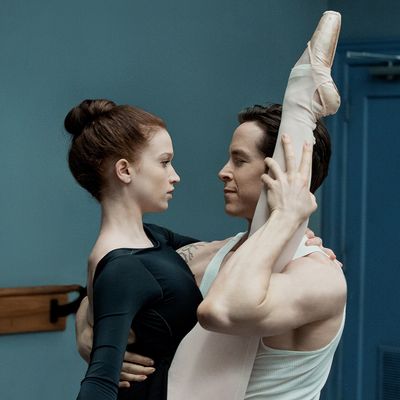
The new Starz series Flesh and Bone is filled with clich├®s, but theyÔÇÖre melodrama clich├®s, specifically ballet melodrama clich├®s, and that automatically makes them feel less wearisome than cop or gangster clich├®s; and the more familiar elements are counterbalanced by an occasionally overwhelming sense of visceral realism. Most of the cast is composed of professional dancers or actors who either danced professionally or were in training to do so until an injury pushed them out. There are no doubles onscreen ÔÇö what you see is what you get. And what you get is not pretty, despite the elegance and lean precision of the performers as their bodies cut through space.
Created by Breaking Bad writer-producer Moira Walley-Beckett, who penned the seriesÔÇÖ most controversial episode, ÔÇ£Ozymandias,ÔÇØ this is a show that is first and foremost about how people suffer for their art to escape or transcend their lives, only to see the art become a different kind of prison, or another addiction. And, wow, do they suffer. A good many of the dancers in the fictional New YorkÔÇôbased dance company are medicating (in some cases self-medicating) for physical or emotional pain: popping Vicodin or Percocet and, in one case, doing coke. There are more than a few close-ups of feet in the first couple of episodes, and they arenÔÇÖt dainty feet. They might as well be boxersÔÇÖ knuckles.
ThereÔÇÖs a lot of sex on the show, much of it expressing domination and momentary escape rather than reassuring intimacy, much less love. There are also moments in daily life of the troupe where dancers touch other dancers, or choreographers touch dancers, in a way that is not so much about instruction as it is psychological warfare, or the implicit equating of sexual intimacy and protected status: ÔÇ£Of all the dancers in this troupe, you are the most special one, and thatÔÇÖs why IÔÇÖm touching you this way.ÔÇØ One of the characters has a second job as a pole dancer in a Russian-run strip club that forbids its employees to touch the customers, but looks the other way when they arrange for off-site rendezvous. You might think this bit of information would make the troupe look good in comparison, but no: A possible benefactor considers writing them a fat check, but only if he can spend the night with a particular dancer.
All of this is expressed through characters that you pretty much get immediately and who donÔÇÖt reveal many new shadings when you spend more time with them in episodes one and two. The main character, Claire (Sarah Hay), is a quiet, neurotic, sexually repressed, self-punishing type, like the heroine of Black Swan, a film with which Flesh and Bone appears to have nothing in common otherwise. Claire just got a job at the company but finds herself instantly (and maybe improbably) being groomed as a star by the director, Paul (Ben Daniels), a handsome, domineering prima donna who fucks young guys over his desk during lunch breaks but also seems genuinely sexually avaricious toward some of the women in his employ (though a good part of that might be tactical). ÔÇ£DonÔÇÖt tell me what I can and cannot do!ÔÇØ he exclaims when an underling questions his judgment. ÔÇ£Everyone and everything here is mine to do with as I will!ÔÇØ As in a lot of stories set among performers, thereÔÇÖs an All About Eve rivalry happening between our green heroine and a veteran of the troupe: Claire threatens to eclipse Kiira (Irina Dvorovenko), and to prevent that, Kiira sets about undermining her. She has plenty of help: Nobody seems to like the new girl. ÔÇ£Her tits are a two-count behind,ÔÇØ another dancer says of her during a rehearsal. ÔÇ£YouÔÇÖre not special, you know that, right?ÔÇØ Kiira asks Claire, one of those yes-or-no questions that a person is better off not answering.
IÔÇÖm making the show sound terrible or hopelessly glum or both; itÔÇÖs actually fairly engrossing if you can get past the exposition-dump pilot, and if you can factor out an especially gross and ill-advised subplot (youÔÇÖll know almost immediately which one I mean). The second episode settles into an appealingly masochistic-morose groove and gives what I can only assume is a somewhat more accurate picture of the grind that is working with and for a ballet troupe. There are fairly lengthy sections showing the emotional dynamics of a rehearsal and a couple of surprisingly involved arguments about the pros and cons of commissioning a new ballet versus performing something tried-and-true, and the merits and drawbacks of putting a fresh new face in a lead role even though you have no idea whether she can handle the physical demands or the emotional pressure. The showÔÇÖs biggest problem is that it canÔÇÖt quite decide if it wants to be a delicious and outrageous melodrama or a series thatÔÇÖs more into atmosphere and realism. The two modes donÔÇÖt mix easily, but by the second episode it seems as though itÔÇÖs beginning to figure itself out. Either way, itÔÇÖs filled with magnificent-looking performers in peak physical condition, and it spends a good part of its screen time just watching them move instead of talk. TV could use more of that kind of thing.


